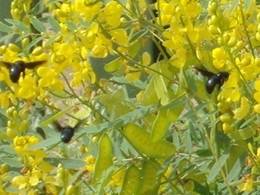Low rainfall ( below 500 mm/yr) combines with high variability in rainfall , wide range of annual temperature range form 0oC to 49o C and light soils, makes a complex where agriculture is a challenge in these areas. Many a times crops either not able to complete life cycle or yield poorly due to this complex of climatic conditions. Production systems with annuals (crops) and perennial (trees, shrubs and grasses) has been following traditionally in this region to spread the risk of climatic uncertainty and to get food , fodder and fuel for sustenance of life. Since traditional system was based on integrated use of local resources and no use of chemicals therefore, system is known as default organic. Although immense tradition wisdom involved in the development of this system hence bettor word is designed organic, rather default organic . This system still prevalent in many parts of these areas. As mentioned earlier productivity of this system is low that is mainly due to inefficient methods of preparation and application of organic inputs. Therefore if these technologies can be improved and use integratedly there is every possibility of achieving sustainability combines with high productivity in these areas of second green revolution ,as the support system for organic farming is already available.
ORGANIC AGRICULTURE : SUITABLE TO SOCIETY AND ECOLOGY
- Diversified farming system :Farming systems in the region are highly diversified in nature with crops, trees, animals, grasses etc. This system is scientifically efficient in nutrient recycling and restoration of soil fertility. In these systems 10-30 trees/ha are available and 2-5 animals are reared by a farm family. This integrated farming system minimizes pest incidence as well as favors organic farming and controls desertification.
- Rich traditional wisdom : Rich traditional wisdom in these areas for restoration of soil fertility and for pest control further strengthen and provide strong infrastructure for organic system.
- संसाधन की प्राकृतिक उपलब्धताः :
जैव कीट नाशक के प्राकृतिक स्त्रोत वाले पेड़ यथा नीम, आंकड़ा आदि इस क्षेत्र में बहुलता से उपलब्ध है। खनिज यथा जिप्सम, चूना, राॅकफाॅस्फेट आदि भी यहाँ बड़ी मात्रा में मिलते है। ये मृदा सुधारक साथ ही पोषक तत्व प्रदान करने वाले है। कृषि पद्धति प्रमुखतः पशु आधारित है। पशुओं से प्राप्त अपशिष्ट और उसके उत्पाद संतुलित पोषक तत्व देने हेतु अच्छे स्त्रोत हो सकते है।
- रोजगार के अवसर : कम वर्षा और सीमित मात्रा में सिंचाई के साधनों के कारण अधिकांश मानव शक्ति वर्षपर्यन्त कम प्रयुक्त होती है। सूखे के समय मानव प्रव्रजन राज्य के विकास को असंतुलित करता है। चंूकि जैविक खेती श्रमिक आधारित है तथा यह स्थानीय स्तर पर ही प्राप्त की जा सकती है। अतः जैविक खेती से रोजगार और मानव संसाधन के उचित प्रयोग के पूर्ण अवसर उपलब्ध है।
- मृदा सुधार : मृदा की जल धारण क्षमता कम है तथा आवश्यक पोषक तत्वों की कमी भी है। अतिरिक्त जैविक, खाद देने से न केवल मृदा की जल धारण क्षमता का सुधार होगा अपितु उसे समुचित मात्रा में पोषक तत्व भी प्राप्त होगें। इस प्रकार का रूझान (श्री रमेश जी (आदि) द्वारा) जैविक फार्मो पर भारत में किये गये मृदा तत्वों के सर्वेक्षण के अन्तर्गत प्राप्त किये गये।
- जलवायु परिवर्तन का मुकाबला : प्रतिवर्ष नत्रजन उर्वरक प्राप्त करने की प्रक्रिया में पूरे विश्व में लगभग 90 मिलियन टन खनिज तेल या प्राकृतिक गैस का प्रयोग किया जाता है। इस प्रक्रिया में 250 मिलियन टन कार्बनडाईआक्साइड का उत्सर्जन होता है। इसके विपरीत जैविक फार्म से 515 से 700 किग्रा कार्बनडाईआक्साइड मृदा को प्राप्त होती है। इस प्रकार जैविक खेती सिंथेटिक फर्टिलाइजर को हटाकर कार्बनडाईआक्साइड उत्सर्जन को कम करती है और इसी के साथ मृदा में इस गैस का संग्रहण कर वातावरण में इसके संकेन्द्रण को कम करती है। साथ ही जलवायु परिवर्तन के दुष्प्रभाव को आत्मसात कर लेती है।
काजरी में मॉडल जैविक फार्म
कम वर्षा वाले क्षेत्रों में जैविक खेती की प्रबल संभावनाओं को ध्यान में रखते हुए तथा जैविक उत्पादकों का प्रायोगिक प्रदर्शन द्वारा वैज्ञानिक आधार बताने हेतु सन् 2008 में केन्द्रीय शुष्क क्षेत्र अनुसंधान संस्थान (काजरी) जोधपुर में एक माॅडल जैविक फार्म की स्थापना की गई। फार्म का प्रमाणीकरण हेतु पंजीकरण किया गया तथा सन् 2011 में इसे प्रमाणीकृत जैविक फार्म का दर्जा दिया गया। जैविक पद्धति हेतु पूर्णतया सक्षम बनाने के लिए यहाँ निम्न सुविधाओं का विकास किया गया।
- फार्म के चारों तरफ वर्षा जल संग्रहण और बाह्यक्षेत्र से आये बहते पानी से (कन्टेमिनेशन) प्रदूषण से बचाव हेतु बाढ़ बन्दी की गई।
- वर्षा जल संग्रहण के 5000 लीटर क्षमता (प्रत्येक) के दो टांको का निर्माण जैविक फार्म पर किया गया।
वर्षा जल के अधिकतम संग्रहण हेतु चारों तरफ सीमेन्टेड जलसंग्रहण क्षेत्र बनाया गया। इस संग्रहण क्षेत्र का प्रयोग सूखे के समय में फसल को सुखाने और साफ करने आदि में किया जाता है। इस वर्षा जल का प्रयोग कम सघनता वाली उच्च मूल्य की फसलो जीरा, ईसबगोल आदि में किया जाता है।

Rainwater harvesting tank
- वर्षा जल संग्रहणः मानव श्रम द्वारा निरन्तरतः निराई गुडाई की जाती है तथा तोड़े हुए खरपतवार को छायावरण के रूप में बिछा दिया जाता है जो बाद में अपघटित होकर जैविक पदार्थ 1.5-2.0 टन/हे./वर्ष प्रदान कराता है।
- अस्थायी और स्थानिक आधार पर आवर्तन में फसल बुवाई करके जैव विविधता को बनाये रखा गया है।

काजरी फार्म (एम.ओ.यू.) में कृषि विविधता
- Biodiversity plantation was done in the model organic farm of 12 fruit and flowering plants, native of the area. Besides, naturally grown about 30 plants of P.cineraria (khejri, an MPTS) were also protected. This plantation ensures nectar supply and shelter to the beneficial insects/birds.


मॉडल जैविक फार्म पर उपयोगी पादप
- फार्म के एक कोने में कम्पोस्ट खाद बनाने के लिए एक गड्डा बनाया गया है जिससे उसमें फसल अवशेष/अपशिष्ट डालकर कम्पोस्ट खाद बनाई जा सके। फार्म के संग्रहण टैंक में नीमोली और नीम की पत्तियांे से जैव कीट नियन्त्रक बनाया जाता है। कीटों को पकड़ने हेतु फर्मनटेªप फार्म में लगाई गई है जो सफेद मक्खी, मोठ आदि हेतु प्रभावकारी रूप से कार्य कर रही है।

काजरी के माॅडल जैविक फार्म की उपलब्धिः
शम्मीधान्य में योगदान : पश्चफसल में शमीधान का 25-30 प्रतिशत उच्च उपज का योगदान होता है। रबी ऋतु में जीरा और ईसबगोल को आवर्तन में तिल और अरण्डी के साथ बोया जाता है। जीरे की उपज 566 किग्रा/हे. और ईसबगोल की 808 किग्रा/हे. जैविक देय और ग्वार के साथ आवर्तन में बुवाई से प्राप्त की गई।
फसल उपज की तुलना : यह सामान्य धारणा है कि जैविक पद्धति में कम उपज होती है। काजरी के अध्ययन यह बताते है कि जैविक पद्धति में प्रारम्भ में 20-30 प्रतिशत कम उपज हुई परन्तु 2-3 वर्ष पश्चात् इस पद्धति में परम्परागत पद्धति की अपेक्षा अधिक उपज की प्राप्ति होती है। तीसरे वर्ष तिल की उपज 886 किग्रा/हे., ग्वार 630 किग्रा/हे., जीरा 516 किग्रा/हे. और ईसबगोल 808 किग्रा/हे. दर्ज की गई। यह परम्परागत पद्धति की तुलना में औसत वृद्धि थी।
Sink Partitioning : As the manure level increased, percentage of sink to grain increased from 15.7 to 19.8% while it decreased in case of stem and leaf. This shows better partitioning of sink that increased grain yield, with the application of manure. It may be due to balanced nutrition through compost that used by plant for grain formation
मृदा तत्वों में सुधार :जैविक खाद के प्रयोग से मृदा नमी धारण क्षमता में सुधार हुआ जिससे फसल की वृद्धि दर और उपज अच्छी रही। इसी प्रकार पाँच वर्ष कम्पोस्ट देने के बाद मृदा आॅरगनिक कार्बन में 0.23 प्रतिशत से 0.31 प्रतिशत तक वृद्धि हुई।
जलवायु सहनीयता : पाँच वर्ष के प्रयोगो से ज्ञात हुआ कि जैविक खाद देने से फसल में जलवायु की विभिन्नता को सहन करने की क्षमता में वृद्धि हुई।
जैव-विविधताः : इन वर्षो में लाभदायक जैव विविधता में वृद्धि रही विशेषतः कोशिनिलिड बीटल, क्राइसोफरला, सिरफिड मक्खी, विभिन्न प्रकार के पीले तैतेया बम्बल बी मधुमक्खी आदि की संख्या में वृद्धि हुई जबकि अच्छे विघटित कम्पोस्ट खाद के प्रयोग के कारण दीमक (टरमाइट) की कमी हुई।
Pest Management : Pest were kept below Economic threshold level with the integrated use of use of following eco- technologies –
- Soil application of neem cake
- Use of well prepared compost
- Trichoderma viride application in soil and seed treatment
- Use of healthy seed ( also free from weed seeds)
- Hand weeding and mulching
- Prophylactic spray of neem seed kernel extract solution(5.0%) at regular interval
- Use of pheromone traps according to the pest




Organic farming is a holistic production system run with the efficient use and recycling of locally available resources. Due to scarcity of water and light soils areas it is best suitable and applicable arid areas. Some monopoly high value crops of this region like seed spices are having great international demand if produce organically. Organic production in arid areas not only boost the economy of this region but also sustain the productivity of natural resources and meet the challenges of changing climate. The need is to do research on development of easy & economic technologies, development of processing and marketing infrastructure and financial well as technical support for quality organic production.
Dr. A.K. Sharma, Sr. Scientist, Email: aksharma@cazri.res.in

